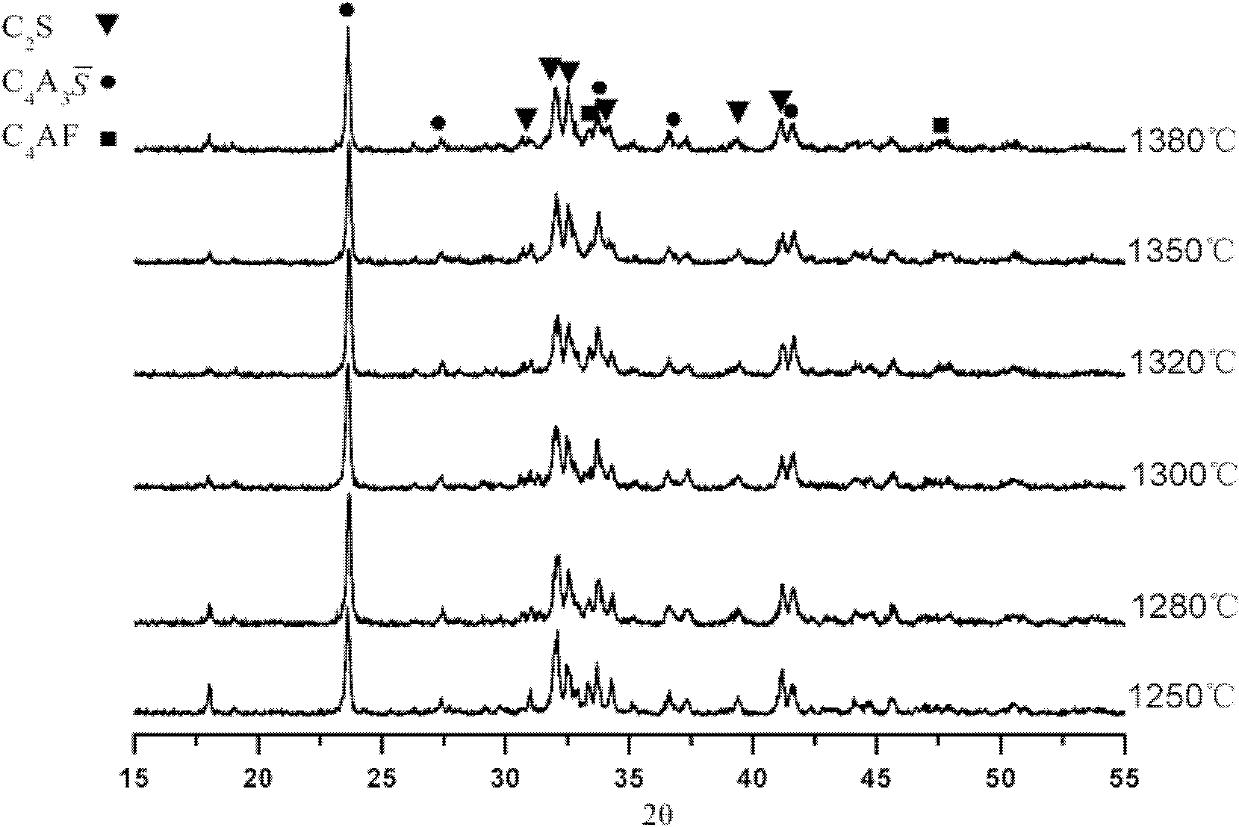Low-energy-consumption and low-emission cement and preparation method and application thereof
A low-emission, low-energy-consumption technology, applied in cement production, clinker production, etc., can solve the problems of high energy consumption, large consumption of high-calcium raw materials, etc., and achieve the effects of reducing heat consumption, reducing energy, and saving coal consumption
- Summary
- Abstract
- Description
- Claims
- Application Information
AI Technical Summary
Problems solved by technology
Method used
Image
Examples
Embodiment 1
[0044] Embodiment 1, preparation of low energy consumption, low emission cement raw meal
[0045] The raw materials used to prepare the cement product of the present invention include: limestone, bauxite, gypsum and clay (or sandstone), all provided by Tangshan Polar Bear Building Materials Co., Ltd.
[0046] 1. Selection of raw materials
[0047] The above raw materials were pretreated respectively, including drying (105°C), crushing by a crusher, grinding and homogenizing by a ball mill, and samples were taken for full analysis of chemical components. The results are shown in Table 1:
[0048] The chemical composition (weight percent) of table 1 raw material
[0049] sample
L.O.I.
SiO 2
al 2 o 3
Fe 2 o 3
TiO 2
CaO
MgO
SO 3
K 2 o
Na 2 o
limestone
42.72
0.78
0.31
0.08
/
54.77
0.67
/
0.04
0.05
14.68
4.78
74.91
...
Embodiment 2
[0061] Embodiment 2, low energy consumption, low discharge cement clinker calcining and the preparation of cement
[0062] According to the composition design of eight different clinker minerals in Table 2, eight groups of corresponding raw meals were prefabricated. For the raw materials used, refer to Table 1 in Example 1.
[0063] Table 2 mineral composition design (wt%)
[0064]
[0065] 1. Raw meal flammability test: the eight groups of samples in Table 2 are made into small samples with a diameter of 34mm, placed in a muffle furnace at 950°C (850-950°C is acceptable) and pre-fired at a constant temperature for 30min. Put it into silicon-molybdenum rod electric furnace at 6 temperatures: 1250°C, 1280°C, 1300°C, 1320°C, 1350°C and 1380°C for 30 minutes at constant temperature, then take out the clinker quickly and cool it to room temperature with a fan, and grind it to pass through an 80μm test sieve According to GB / T 176-2008 "Methods for Chemical Analysis of Cement", ...
Embodiment 3
[0074] Embodiment 3, the optimization of low energy consumption, low emission cement clinker mineral components
[0075] The optimization experiments all adopt the following method to prepare cement samples: place the dried raw material test cake (the large sample in Example 1, φ118mm × 118mm) on a platinum sheet, and put it into a muffle furnace with a temperature of 950°C Pre-fire at a constant temperature for 45-70 minutes, then immediately transfer the pre-fired test cake together with the platinum sheet into a high-temperature furnace with a constant temperature of 1280°C-1300°C, and calcine at a constant temperature for 45-70 minutes to obtain cement clinker, which is mixed with 5% cement by weight Anhydrite becomes a cement sample.
[0076] 1. In clinker Determination of weight percentage
[0077] Ingredients according to the following design scheme: fixed C 4 AF content of 9%, C 2 S content varies in the range of 35-65%, Mineral contents are 22%, 27%, 32%, 37%, ...
PUM
| Property | Measurement | Unit |
|---|---|---|
| Compressive strength | aaaaa | aaaaa |
| Strength | aaaaa | aaaaa |
Abstract
Description
Claims
Application Information
 Login to View More
Login to View More - R&D
- Intellectual Property
- Life Sciences
- Materials
- Tech Scout
- Unparalleled Data Quality
- Higher Quality Content
- 60% Fewer Hallucinations
Browse by: Latest US Patents, China's latest patents, Technical Efficacy Thesaurus, Application Domain, Technology Topic, Popular Technical Reports.
© 2025 PatSnap. All rights reserved.Legal|Privacy policy|Modern Slavery Act Transparency Statement|Sitemap|About US| Contact US: help@patsnap.com



